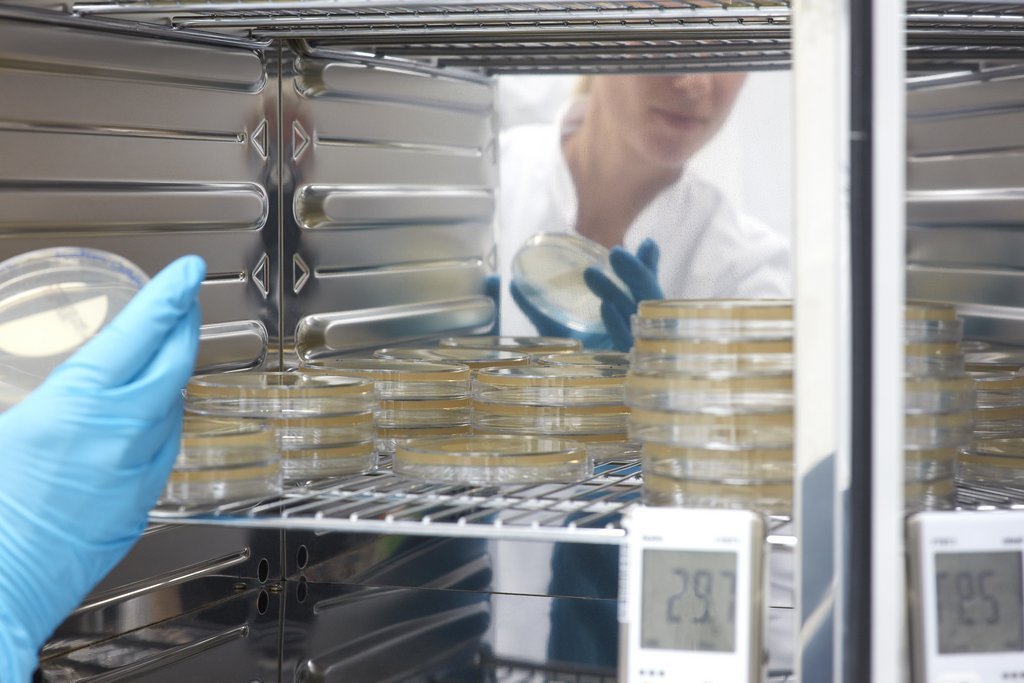Bioburden determination including validation
The term bioburden refers to the total number of germs on a surface. The aim of a bioburden determination is to determine the exact number of viable microorganisms (fungi and bacteria) on the surface of, for example, medical devices. It is used for quality control of medical devices as well as components used in the medical field. For this reason, manufacturers of sterile medical devices are required by GMP (Good Manufacturing Practice) and the MDR (Medical Device Regulation, EU 2017/745) to have a bioburden determination with validation performed on their products.
The bioburden determination is an important step for the validation of a sterilization process and also serves as a process-related quality check in the course of manufacturing or cleaning a medical device.
How is a bioburden determination made?
To determine the total number of germs on the surface, the product is either placed directly in a nutrient medium or the surface of the product is rinsed with a sterile solution. The rinsing medium is then filtered through a sterile membrane and the membrane is then applied to one or more nutrient media. The sewing media are incubated for a period of several days. At the end of the incubation period, the colonies of microorganisms formed are counted.
The number of colonies formed then corresponds to the number of so-called CFUs (colony-forming units). These are individual microorganisms or groups of microorganisms that have adhered to each other and were originally present on the product.
By using different nutrient media and incubation conditions, a rough differentiation of fungi and bacteria is initially possible. If further selective media are used, further specification of the microorganism found is possible, particularly in the area of bacterial colonization. This information can then be used to narrow down the cause and origin of contamination during production or purification.
What does validation of the test method mean?
The efficiency of the test method for bioburden determination is influenced to a considerable extent by the material and the geometry of the medical device. For this reason, a validation of the test method should take place once for each product to be tested. For this purpose, the product to be tested is inoculated with a known number of a known test organism and subsequently tested with clearly defined parameters. At the end of the test, the colony-forming units found are counted and compared with the number originally applied. The resulting ratio represents the so-called recovery rate.
The validation of the test method for bioburden determination is carried out according to the specifications of DIN EN ISO 11737-1. This recovery rate is then used to calculate a correction factor. This is included in all subsequent bioburden determinations on this product, whereby these must be carried out with exactly the same parameters as in the validation.
Bioburden determination with validation by our accredited and GLP recognized laboratory
CleanControlling Medical GmbH & Co. KG is a GLP recognized and DIN EN ISO/IEC 17025 accredited testing laboratory for cleanliness testing of medical devices. As a testing laboratory recognized by the ZLG, we offer our customers a wide range of tests with which the chemical, biological and particulate cleanliness status of medical devices can be determined, as well as the validation of reprocessing instructions.
The accreditation confirms that our testing laboratory meets internationally applicable quality and competence requirements. This ensures that the test results obtained are internationally comparable and recognized. Accreditation by the German Accreditation Body according to DIN EN ISO 17025:2018 in the field of medical devices is objective proof of the quality of the services offered and the competence in the activities of a testing laboratory. The commissioning of an accredited testing laboratory is a mandatory prerequisite, for example, for validations as well as in approval procedures, so that the test results can be recognized during audits.
Our test facility is in the national GLP monitoring procedure and is therefore regularly monitored for compliance with the principles of good laboratory practice according to the Chemicals Act and 2004/9/EC. Good Laboratory Practice (GLP) represents a quality assurance system for laboratories performing non-clinical testing in the health and environmental fields. The GLP recognition of our testing laboratory enables the mutual recognition of tests performed by our laboratory in accordance with the principles of GLP by the regulatory authorities of the OECD member states (Europe, USA, Canada, Japan, Mexico, Australia and other countries). This means, among other things, that the test results are also accepted by the FDA.
CleanControlling Medical - Your strong partner for biological and microbiological-hygienic testing of medical devices
CleanControlling Medical GmbH & Co. KG, as an accredited testing laboratory for medical devices, relies exclusively on qualified and competent testing personnel with an appropriate academic education (doctorate, bachelor/master biology, biotechnology) as well as on well-trained biological-technical assistants. This enables us to offer you a comprehensive range of services - including personal support in interpreting the test results, for which we also visit your production and packaging areas on site if required.
We prepare the test results and reports bilingually (in German and English) and, of course, in compliance with FDA regulations. Our company headquarters are located in the heart of the "world center of medical technology"; this means that we are optimally networked and in constant exchange with many international medical technology giants. In addition, we offer a free pick-up service for test items for customers in the Tuttlingen area.
Do you have any questions about bioburden determination or other of our services and products? We are available by telephone from Monday to Friday from 7:30 a.m. to 4:30 p.m. at +49 7465/92 96 78-0. Or you can use our contact form to send us your request in writing.
Newsletter registration

